|
17.Papilio machaon Linnaeus, 1758 / Swallowtail / Papilionidae – Papilioninae
NL: koninginnepage, koninginnenpage / D: Schwalbenschwanz / F: machaon, le grand porte-queue
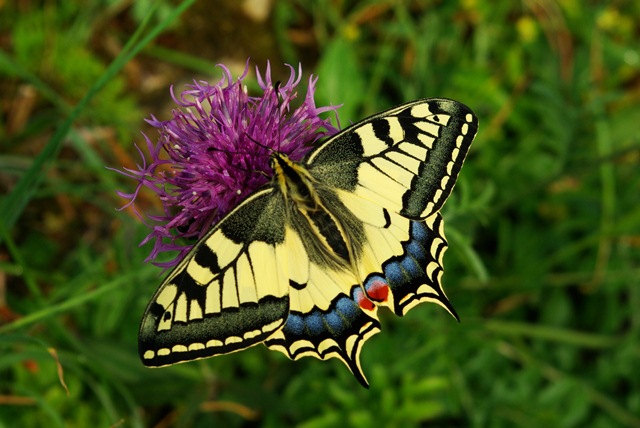 
Photographs: Frits Bink ©.
Large or very large, wing length male 36 (32-38) mm, female 38 (35-41) mm. In the southern part of the Benelux always present, in the northern part absent in periods of unfavourable summer weather. It is a remarkable species because it is able to live in Mediterranean and also in subarctic climate.
Butterfly is on the wing in the Benelux end-April until early-June, peaks late May, second brood mid-July until early-September, peaks late-July and occurs in dunes, marshes, grassland on hills mildly grazed by cattle and in the countryside on verges of country roads, gardens and often in allotment/garden complexes. The species occurs in climates ranging from maritime to severe continental, amplitude 5 to 20. The required heat sum is 200°d, the maximum tolerated 3600°d and the corresponding climate window is 15 weeks and the whole year open.
The species occurs irregularly in countries such as Denmark and the Netherlands and adjoining regions, where the climate of warm and dry summers is required for two broods per year; however, in cool and wet summers unsuitable even for a single brood. The unpredictability of the climate from year to year, where the heat sum fluctuates between 700°d and 900°d, results in some years in the disappearance of the species. In eastern England a population of Papilio machaon brittanicus occurs in the same climate range but there it is stable because it is generally univoltine and only exceptionally do adults of a second brood appear, as was the case in the hot, dry summer of 1976.
This was deleterious for the survival of the population because of the poor growing conditions of the local host-plant, milk parsley (Peucedanum palustre).
Ecological characteristics
Behaviour over time
Overwintering: pupa attached to trunk or stone near to the soil or to the branch of a shrub.
Reproduction: oviposition starts after 2 to 5 days when the body contains 65 (24-80) eggs. Observed potential production is 5.5 times as much and required oviposition time 3 weeks (Data Christer Wiklund 1986, egg production per female: 357 ± 92, n=14).
Larval feeding periods: 4 to 5 weeks in the period from mid-May until end-September.
Generations: depending on the local climate, one in cool but up to three in warm.
Spreading of risk: spread in hatching of the pupa in spring, prolonged diapause over years.
Life cycle: egg 7 (5-12) days; larva 30 (22-36) days; pupa 18 (13-22) days, up to 29-46 weeks, sometimes more than 80 weeks.
Life span of adult: rather long, 3 weeks.
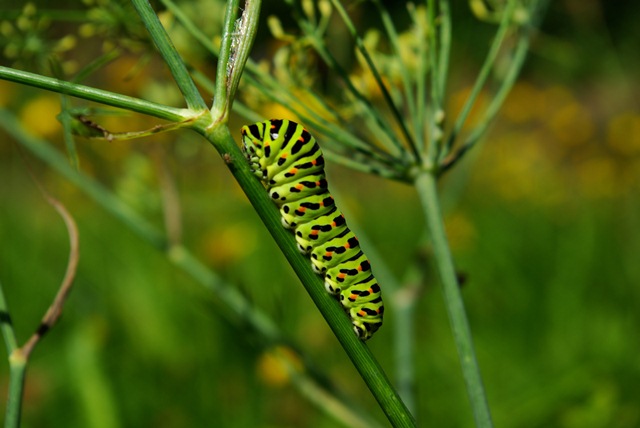 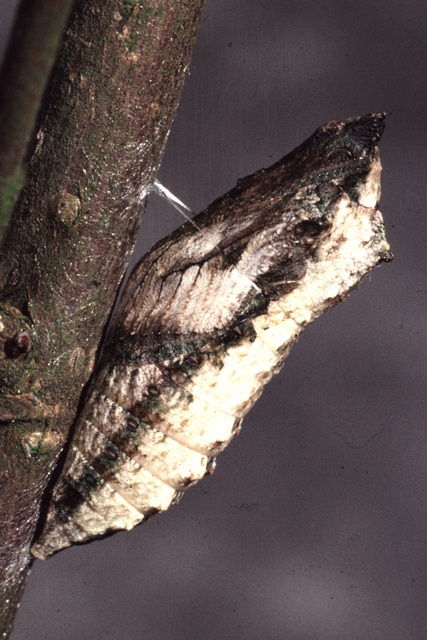
Photographs: Frits Bink ©.
Behaviour in space
From stay-at-home to migrant: a nomad that can migrate over long distances.
Finding a mate: males congregate on hill tops or any remarkable landmark in the landscape where they wait for females.
Orientation in the landscape: on large structures such as seashores, river banks, but also on small ones as mosaic pattern in vegetation structure. Arable fields with carrot are almost ignored, small beds in gardens well accepted.
Oviposition: in most cases precisely on flower buds or young sprouts. Sometimes a few eggs are laid on host plants not normally used as host-plants.
Defence
Threats from other organisms: the larva when small looks like a bird dropping, when large it is cryptic coloured at a distance but when seen closeby repulsive. It is also armed with an osmeterium but nevertheless it has a specific parasite, the large ichneumon wasp (Trogus lapidator).
Threats from the environment: during the period when the butterfly is on the wing, it is vulnerable to cold and rainy weather.
Feeding habits
Adult: nectar, all kinds of large flowers which can support a visit of this large butterfly.
Larva: there is a preference for young leaf or flower bud, but development on old leaves may be successful.
Larval foodplants
Plant species: Apiaceae, a great number of plant species e.g. Anethum graveolens, Angelica archangelica, A. sylvestris, Crithmum maritimum, Carum carvi, Daucus carota, Foeniculum vulgare, Pastinaca sativa, Peusedanum carvifolia, P. palustre, Pimpinella saxifrage, Silaum silaus. Rutaceae, Ruta graveolens.
Journal
Rearing experiment based on specimen from Lion devant Dun, France:
12 June 1984: a fertile female captured.
17 June: 52 ova laid on Daucus carota and 17 on Ruta graveolens.
20 June: first eggs hatch.
2 July: one larvae in moult L2-3, the remainder in L1/2.
14 July: larvae on Ruta in moult L4-5.
16 July: larvae refused to change host-plant when already feeding on one of the host-plant species.
30 July: last larva pupating.
5 August: first adult appeared, male.
8 August: third one, male.
13 August: two remaining pupae in diapause.
Rearing experiment based on specimen from Montmédy, France:
19 August 1984: 6 fresh eggs collected, three females were ovipositing at the site.
26/27 August: eggs hatch.
6 September: larvae in L3.
9 September: biggest larvae in moult L3-4.
22 September: 2 larvae nearly full grown, the others mid-L5.
28 September: first pupa.
30 September: last larva pupating.
All pupae entered diapause.
Overwintered outdoors.
30 April 1985: first adult appeared, male.
30 April to 7 May: three males hatched.
19 May to 25 May: four females hatched.
Table 17-1. Results of dissections

Table 17-2. Average number of ova laid per female per day. Total number 14 females, starting on 5 June 1986, longevity 18 (14-22) days
[data from Christer Wiklund]

Table 17-3. Collection and observation localities
D, Kaub 50° 05’ 36”N – 7° 45’ 43”E; 26 May 1986.
D, Lorch 300m, 50° 02’ 05”N – 7° 47’ 56”E; 26 May 1986.
E, Las Negras 36° 52’N – 2° 00’W; 22 February 2005.
EST Endla Nature Reserve, 58° 52’ 41”N – 26° 12’ 53”E; 10 July 1999.
F, Brittany, Cancale 48° 40’ 20”N – 1° 51’ 09”W; 25 September 2000.
F, Lorraine, Dieue-sur Meuse 49° 05’ 11”N – 5° 27’ 25”E; 19 August 1984.
F, Lorraine, Lion-devant-Dun 300 m, 49° 23’ 40”N – 5° 14’ 03”E; 12 June 1984.
F, Normandy, Quinéville 49° 31’ 52”N – 1° 17’ 59”W; 5 September 2005.
F, Vosges, Bollenberg 363 m, 47° 56’ 54”N – 7° 15’ 21”E; 11 June 1984, 25 July 1983.
F, Favières, Mont d’Anon 438 m, 48° 28’24”N – 5° 57’ 55”E; 28 July 1983.
F, Lion devant Dun 300 m, 49° 23’ 40°”N – 5° 14’ 03”E; 12 June 1984.
F, Montmédy 217 m, 49° 31’ 07”N – 5° 21’ 33” E; 19 August 1984, 7 June 2002.
F, Pagny-la-Blanche-Côte, 322 m, 48° 32’ 01”N – 5° 44’ 14”E; 7 July 2006.
L, Kautenbach 316 m, 49° 57’18”N – 6° 00’ 59”E; 21 June 2006.
NL, Bennekom 51° 59’ 30”N – 5° 40’ 34”E; 26 April 2011, 7 May 2011.
NL, Kortgene 51° 34’N – 3° 48’E; 20 September 2003.
S, Gotland, Folhammar 57° 20’ 49”N – 18° 44’ 12”E; 19 June 2004.
S, Gotland, Häftings 57° 52’ 41”N - 18° 37’ 22”E; 17 July 2004.
S, Gotland, Grodde 57° 52’ 01”N – 18° 49’ 02”E; 2 July 2004.
S, Gotland, Lickershamn 57° 50’ 17”N – 18° 34’ 54”E; 3 July 2004.
Fig. 17-1. Papilio machaon, phenogram adapted from Fichefet et al. 2008: 67.

Fig. 17-2. Papilio machaon, habitat characteristics.
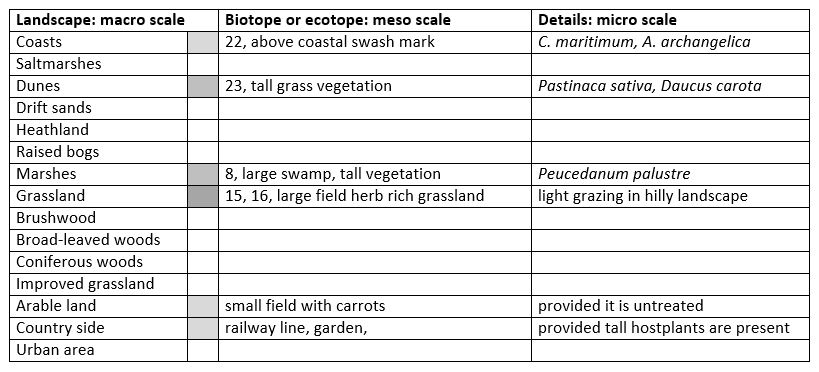
Fig. 17-3. Papilio machaon, climate matrix, heat-sums 200 - 3600°d.
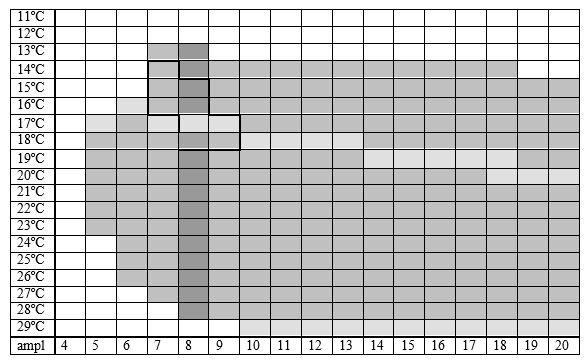
|










